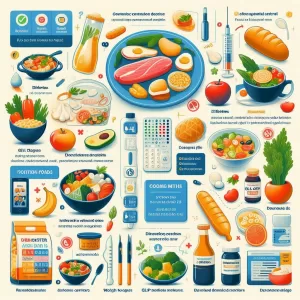What is Diabetes Mellitus (Type 2)?
Diabetes mellitus (type 2) is a condition in which the body’s cells do not respond well to the hormone insulin. Insulin is produced by the pancreas to make sugar in the blood accessible to the body for energy. People with type 2 diabetes have a problem bringing sugar into cells, which causes the sugar to stay in the blood, causing high blood sugar levels.
Symptoms of type 2 diabetes include a frequent need to urinate, producing large volumes of urine, feeling tired, weight loss, and feeling more often thirsty than normal. Type 2 diabetes is managed with a good diet, regular exercise, and medication to reduce blood sugar levels.
Risks
The pancreas is an organ that is placed behind the stomach and is connected to the bowel. It produces substances necessary for digestion and makes hormones (insulin and glucagon) that regulate the body’s sugar (glucose) levels. Insulin is important because it makes sugar in the blood available for use by the body as energy. Type 2 diabetes occurs when the cells of the body no longer respond to insulin, and as a result, do not take up sugar. Type 2 diabetes is most commonly diagnosed in older adults, although an increasing number of younger adults and teenagers are being diagnosed with this condition. People who are overweight, who eat a high-calorie diet, and who do not take regular exercise are more likely to develop this condition. People with a family member who has type 2 diabetes may be more likely to develop this condition. Women who developed diabetes during pregnancy may also be more likely to develop this condition.
Symptoms
The early symptoms are an increased feeling of thirst, frequent urination, and the production of large volumes of urine. People with diabetes often feel tired all the time and may lose weight. Many people, however, do not have any symptoms during the early stages and are diagnosed during routine testing. Later symptoms include frequent infections (for example, skin or bladder infections), slow healing of wounds, blurred vision, and pain or numbness in the feet or hands.
Diagnosis
The diagnosis is often based on the symptoms and testing the amount of sugar in the blood. It is unclear if a person has diabetes, the diagnosis is made by undergoing a glucose tolerance test, during which a measured amount of glucose is given, and the levels of sugar in the blood are measured over a period of time, to see if the body is taking up the glucose as expected.
Treatment
The treatment of type 2 diabetes aims to keep blood sugar levels in the normal range, improve the body’s response to insulin, and prevent the development of any complications. The first steps of treatment involve increasing physical exercise, improving the diet, and maintaining a healthy weight. However, medications or insulin may become necessary over time to reduce blood sugar levels. As the condition progresses, education about using insulin may be needed, including self-monitoring and managing emergencies. Specialist diabetic educators are helpful in providing information and support at all stages of treatment. Regular follow-up is important in order to detect and prevent consequences, such as eye damage and nerve damage.
Prevention
Maintaining a healthy weight, eating a healthy diet, and taking regular exercise can help to prevent some cases of type 2 diabetes.
**Q: What is Diabetes Mellitus (Type 2)?**
**A:** Diabetes Mellitus (Type 2) is a chronic metabolic disorder characterized by elevated blood glucose levels due to insulin resistance and/or insufficient insulin secretion. It is the most common form of diabetes, accounting for approximately 90-95% of all cases.
**Key Points to Know:**
* **Insulin:** A hormone produced by the pancreas that helps glucose enter cells for energy.
* **Insulin Resistance:** When cells become less responsive to insulin, leading to higher blood glucose levels.
* **Insufficient Insulin Secretion:** When the pancreas does not produce enough insulin, resulting in elevated blood glucose levels.
**Causes and Risk Factors:**
* **Genetic Predisposition**
* **Obesity and Physical Inactivity**
* **Age (over 45)**
* **Family History**
* **High Blood Pressure**
* **High Cholesterol**
* **Gestational Diabetes**
**Symptoms:**
* Excessive thirst
* Frequent urination
* Unexplained weight loss
* Increased hunger
* Fatigue
* Blurred vision
* Slow-healing sores
* Numbness or tingling in hands or feet
**Diagnosis:**
* Fasting Blood Glucose Test
* Oral Glucose Tolerance Test
* HbA1c Test (measures average blood sugar levels over the past 2-3 months)
**Treatment:**
* **Lifestyle Modifications:** Weight loss, regular exercise, and a balanced diet
* **Oral Medications:** Metformin, sulfonylureas, DPP-4 inhibitors, GLP-1 agonists
* **Insulin Therapy:** Injections of insulin to help lower blood glucose levels
**Complications:**
Uncontrolled diabetes can lead to serious complications, including:
* Cardiovascular disease
* Stroke
* Kidney disease
* Retinopathy (eye damage)
* Neuropathy (nerve damage)
* Amputations
**Prevention:**
* Maintain a healthy weight
* Engage in regular physical activity
* Follow a balanced diet
* Manage risk factors (e.g., blood pressure, cholesterol)
One comment
Leave a Reply
Popular Articles








Just diagnosed… any information you can give me.